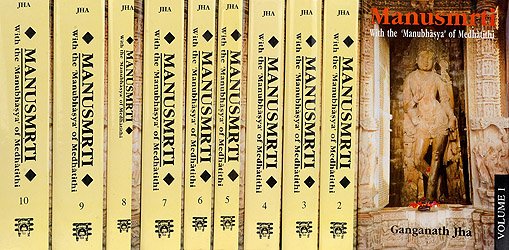Manusmriti with the Commentary of Medhatithi
by Ganganatha Jha | 1920 | 1,381,940 words | ISBN-10: 8120811550 | ISBN-13: 9788120811553
This is the English translation of the Manusmriti, which is a collection of Sanskrit verses dealing with ‘Dharma’, a collective name for human purpose, their duties and the law. Various topics will be dealt with, but this volume of the series includes 12 discourses (adhyaya). The commentary on this text by Medhatithi elaborately explains various t...
Verse 10.44
Sanskrit text, Unicode transliteration and English translation by Ganganath Jha:
पौण्ड्रकाश्चौड्रद्रविडाः काम्बोजा यवनाः शकाः ।
पारदापह्लवाश्चीनाः किराता दरदाः खशाः ॥ ४४ ॥pauṇḍrakāścauḍradraviḍāḥ kāmbojā yavanāḥ śakāḥ |
pāradāpahlavāścīnāḥ kirātā daradāḥ khaśāḥ || 44 ||The Puṇḍrakas, the Coḍas, the Draviḍas, the Kāmbojas, the Yavanas, the Śākas, the Pāradas, the Pahlavas, the Cīnas, the Kirātas, the Daradas and the Khaśas.—(44)
Medhātithi’s commentary (manubhāṣya):
‘Puṇḍra’—and the rest originally stood as names of countries; but in the present context they have been used according to the theory that ‘these names really denote the particular Kṣatriya castes, and are only indirectly applied to countries inhabited by them.’
Pāṇini 4.2.69 lays down the adding of the ‘aṇ’ affix in the sense of habitation, and Sūtra 4.2.81 lays down the elimination of this affix; it is in accordance with this that we have the form ‘Puṇḍra’ (which is formed of the term ‘puṇḍra’ with the ‘aṇ’ affix);—and the elimination is not according to Pāṇini 1.2.54.
The assertion that these people have become ‘low-born’ is based upon the fact that in these countries we do not meet with any dear division of the ‘four castes.’
If however these terms be tried to be used irrespectively of the names of countries, then they should be taken as the names of so many castes.
Some people might be led to think that all these races here named are found to be described as Kṣatriyas, so that they must be Kṣatriyas still. And it is with a view to preclude this idea that it is asserted that these are low-born.
All the people here spoken of form the races inhabiting the borders of Āryāvarta,—such races for instance, as the Kirāta, the ‘Vena’, the ‘Darada’ and so forth; and it is with reference to this that we have the declaration that ‘one should not go to the borders’ (Bṛhadāraṇyaka Upaniṣad, 1.3.10).—(44)
Comparative notes by various authors
(verses 10.43-44)
See Comparative notes for Verse 10.43.
